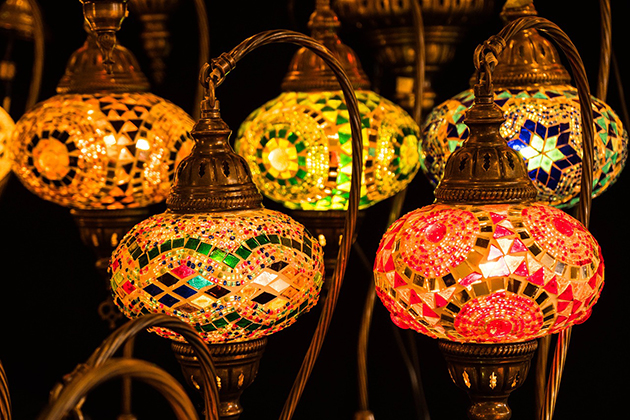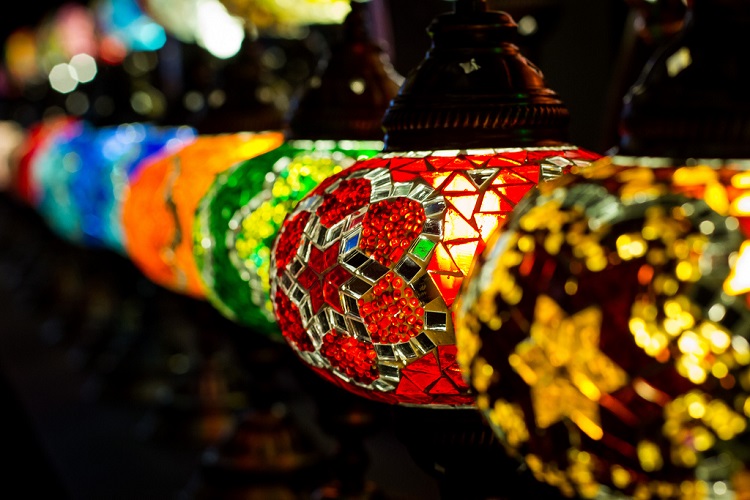What to Look for to Spot a Quality Mosaic Lamps Because They are Not Just Another Pretty Lighting Fixture
Turkish mosaic lamps can trace their origins back to the days before Byzantine Rome ruled the Mediterranean. In fact, the mosaic tradition in Asia Minor - as this part of the world has long been called - is one that has informed the culture and added a sense of vitality to the region since the days of the Sumerians; which pre-date even the great pyramids at Giza. It is this history and these vital cultural associations that inform every genuine Turkish mosaic lamp produced today and it is this indelible heritage that endows each lamp we sell at Paykoc Imports with its distinctive air and sense of timelessness.
The Cultural Significance of Turkish Mosaic Lamps
It’s not clear exactly when the first mosaics were pieced together but one thing is certain: mosaics have played an important role in the culture of what is now Turkey since mankind first began settling into organized communities following the development of agriculture. Mosaics are a key element of nearly every historic site uncovered in this area so it’s clear to see that mosaic lamps are not just some clever idea a decorator had 100 years ago that took off. They are part of the lifeblood of the region, hardwired into the DNA of the people that live there. Mosaics in fact are such an enormous component of the local cultural legacy that there are no fewer than half a dozen major mosaic museums in present day Turkey including:
- Antakya Mosaic Museum
- Great Palace Mosaic Museum
- Haleplibahce Mosaic Museum
- Kariye Mosaic Museum
- Misis Mosaic Museum
- Zeugma Mosaic Museum
Of these Antakya, Haleplibahce and Zeugma Mosaic Museums are among the largest and most important mosaic museums in the world.
Unique Expression Given a Unique Vehicle
The pyramid was a form of architectural expression that arose in various parts of the world whose people had no contact with one another. The pyramid builders of Central America had no way of knowing of the pyramids that loomed above the Giza plateau. Likewise the Chinese were building pyramid shaped tombs 2,000 years ago, long before there was any meaningful contact between the peoples of the Middle East and China.
Mosaics however arose solely in this part of the Mediterranean world. While they were subsequently spread throughout Europe and North Africa by the Romans and can be seen in every corner of the world today, their origins are unique to Asia Minor. And so it is with mosaic lamps. While the idea was plagiarized and popularized in the West by Louis Comfort Tiffany a century ago mosaic lamps arose as a direct arm of the Turkish crafts tradition and as such are a true cultural component of the local people. That’s something that cannot be said for Tiffany lamps, which, while they can be enjoyed on a decorative level, have no real cultural significance.
Beware Cheap Imitations
Over the past 2 decades public markets and discount stores the world over have been flooded with every imaginable type of counterfeit product. From designer handbags to watches to clothes, sports apparel and even cars (Chinese factories produce everything from fake Rolls Royce Phantoms to fake ultra-mini “Smart” cars). Therefore it’s no surprise that fake Turkish crafts, including mosaic lamps, would also come pouring out of the sweatshops of distant countries and find their way onto otherwise respectable retail websites we won’t name here. In order to be sure you are getting the real thing be sure you purchase your mosaic lamps from the most trusted importer of Turkish crafts in the US: Paykoc Imports.
Insist on the Real Thing
Every mosaic lamp we sell is crafted by skilled Turkish artisans, many of whom are 3rd or 4th generation tradespeople. Each lamp is an unsullied example of cultural expression at its best and bound to find a place of honor within your home decor. They also add an air of warmth and comfort to restaurants, taverns, ski lodges and more.
When you’re looking for the perfect item to activate your domestic or business decor look no further than beautiful, engaging, genuine Turkish mosaic lamps from Paykoc Imports. You’ll find a huge collection on this website or stop by our retail outlet on Logan Court in Denver to see them in person.
For more information on how to integrate our amazing mosaic lamps into your home check out or integrating guide
The art of glass making is one that has played a central role in the culture of Asia Minor since the days of the Byzantine Empire. It still finds expression in Turkish handicrafts today, most notably in the stunning mosaic lamps that are such a fixture (excuse the pun) of so many markets in Istanbul. Glass making as an art is generally thought to have reached its pinnacle of sophistication in this part of the world about 500 years ago when the workshops of the day produced myriad glass vases, bowls, flasks and more. It was also during this period when the precursors to the aforementioned Turkish mosaic lamps first appeared.

The Appropriation Problem
Since first appearing in what is now Turkey during the 16th century glass lamp shades have undergone constant refinement. But while they have long been well-known and appreciated throughout Anatolia their beauty was unknown throughout much of the rest of the world until recently. This kind of cultural hibernation meant that when Louis Comfort Tiffany visited Constantinople during the 19th century he was A) astonished by what he found and B) was able to take samples back to the West with him and use them as the inspiration for his own, now legendary lamps.
Tiffany’s coming out party as it were occurred at the 1893 Worlds Columbian Exhibition in Chicago where he displayed his prototype lamps in a setting designed to emulate a Byzantine chapel. It was a subtle nod of appreciation to the land that provided him his inspiration but the reference was lost on most people and is virtually forgotten today. These days most folks believe Tiffany came up with his lamp shade idea all by himself, when his was actually an early example of cultural appropriation.
Tiffany went on to become world famous and fabulously rich from his version of the mosaic lamp while the craftsmen of Turkey continued to labor in obscurity. Fortunately, a growing number of people raised on Tiffany (and the typically low quality knock offs that are currently being mass produced in his name) are coming into contact with Turkish mosaic lamps and discovering LCT might not have been the singular genius everyone assumed him to be. More and more folks are opting for beautiful, handcrafted Turkish lamps and discovering what a valuable addition they can be to home, restaurant, hotel or tavern decor.
Byproducts of Globalization
As Turkish mosaic lamps have gained wider cultural traction in the West their popularity has not gone unnoticed by those who run the knock-off factories in the East. The result is that you’ll often find cheap imitation Turkish lamps in just about every discount store on the planet these days. It’s one of the byproducts of globalization and it raises the question of how you tell a true, high-quality mosaic lamp from a dirt cheap copy produced in a souvenir factory somewhere.
How to Tell Quality Mosaic Lamps from Knockoffs
While there are enough subtle design differences between genuine Tiffany lamps and genuine Turkish mosaic lamps to be able to tell them apart without much trouble that’s not the case when it comes to telling genuine Turkish lamps apart from cheap knock offs. The copy experts have done their homework to the extent that, from a few feet away it might be tough to tell which is the real thing, and which is the copy. So below we’ll provide you with a few things to look for that indicate whether a lamp was really handmade in Turkey or mass produced somewhere else.
- Quality of the glass - When attempting to discern whether lamps are genuine or copies the first thing you’ll want to check on is the quality of the glass. The glass on genuine mosaic lamps is heavy and has a very distinct presence. You can feel it in the surface. Tap the glass gently with your knuckle to determine if it sounds like the real thing. If what you get back is the flat, thin sound of plastic you know you have a copy on your hands.
- Color of the Glass - The glass in a genuine Turkish lamp is handmade with great care given to imbuing it with a deep, rich color. If you’re unsure whether a lamp is genuine or not flip the switch and take a good look at the glass. If it’s pale and the color seems bleached out by the light from the bulb you’re likely dealing with a copy. If on the other hand the color is bold and rich and doesn’t back down from the bulb you’ve probably got a genuine lamp on your hands.
- The Texture of the Base - Real Turkish lamps are made with real bronze bases, not plastic. Bronze has a very different feel to it than plastic does. It also tends to reflect the ambient temperature. So if it’s cold in the room the base will be cold and if it’s hot the base will be hot. More than that though the feel of the bronze itself should be a dead giveaway. So run your hand over the surface of the base. You’ll know if it’s metal or plastic.
- The Weight of the Lamp - Real, handmade glass is heavy. A solid bronze pedestal is heavy. Conversely a cheap plastic shade and pedestal designed to mimic real materials don’t weigh much at all. Pick up the lamp and consider its weight. If it has a real heft to it there’s a good chance it’s genuine. If it weighs about as much as a coffee cup it’s likely a plastic copy.
Buy From The Best
When you purchase your Turkish mosaic lamps from Paykoc you can rest assured that you’re getting a product of Turkish craftsmanship passed down through the centuries. Every one of our mosaic lamps is handcrafted in the workshops of Turkey and imported by us for your enjoyment and appreciation. Don’t waste your time with cheap knockoffs. Buy your mosaic lamp from the #1 source for these astonishing pieces of home decor: Paykoc Imports.
For more information on how to add your mosaic lamp into your home check out our integration guide

 Default Currency
Default Currency
